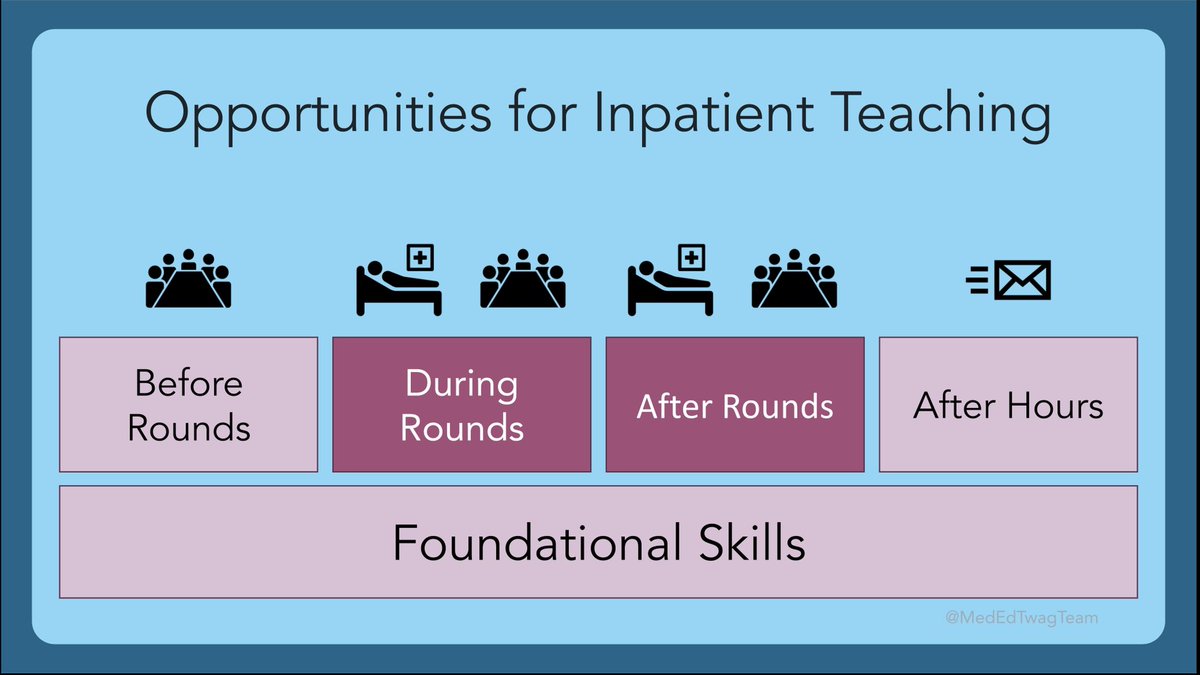1/ Last week, @ChrisDJackson dropped some serious 🔥tips on putting together the content of chalk talks. Check it out if you missed it ⬇️
Part 2 this wk will cover high yield delivery tips!
#MedEd #MedTwitter #MedEdTwagTeam #TweetorialTuesday
Part 2 this wk will cover high yield delivery tips!
#MedEd #MedTwitter #MedEdTwagTeam #TweetorialTuesday
https://twitter.com/ChrisDJacksonMD/status/1541865670614433799

2/ As a reminder, we are still covering teaching in the inpatient setting. Again, chalk talks are fair game both during or after rounds, depending on how much time you have available 

4/ Prep a roadmap - When I was an intern, I was amazed @ residents & attendings who seemed to give talks on the spot. Later, I found out most had already planned & practiced beforehand!
Draft your final whiteboard product on paper, then bring it with you as a cheat sheet.
Draft your final whiteboard product on paper, then bring it with you as a cheat sheet.
5/ Prep a roadmap - As an example: Last year I had a recurring chalk talk on how to do LPs before interns practiced on mannequins. The screenshot here is of a take home card by @AmandaKShep, provided to the learners after the session. I referred to it for my actual chalk talk 

6/ Prep your space - Do you have the 🔑 components for a chalk talk?
✅Is there a board? If not, combine easel-sized post-it notes to create a makeshift “board”
✅Bring markers (Murphy’s law: the ones on the board are all dried up)
✅Arrange learners so all can see the board
✅Is there a board? If not, combine easel-sized post-it notes to create a makeshift “board”
✅Bring markers (Murphy’s law: the ones on the board are all dried up)
✅Arrange learners so all can see the board

7/ Pre-Scribe Your Talk - Block out the important parts of your talk before you even begin. This:
💥Helps you manage board space
💥Saves time
💥Draws interest
💥Primes learners on content & objectives
Example pre-scribed board from the prior LP talk 👇🏼
💥Helps you manage board space
💥Saves time
💥Draws interest
💥Primes learners on content & objectives
Example pre-scribed board from the prior LP talk 👇🏼

8/ Add Visual Interest - The strategies ⬇️ help increase organization of your chalk talk, highlight important points, and thus reduce cognitive load.
Makes it easier for learners to take away 🔑 learning points from your talk
Makes it easier for learners to take away 🔑 learning points from your talk

10/ Face Your Learners - One way to lose audience attention is turning your back to learners for seconds on end while writing on the board. Try to keep your chest @ an angle to your learners (panel D).
Tip: If R handed, stand to R of board. If L handed, stand to L of board
Tip: If R handed, stand to R of board. If L handed, stand to L of board

11/ Pass the Spotlight - The more learners manipulate content, the better it sticks.
With a larger group: pair learners & assign each pair a part of your talk to discuss on their own. Then invite them up to fill in the blanks and teach each other!
With a larger group: pair learners & assign each pair a part of your talk to discuss on their own. Then invite them up to fill in the blanks and teach each other!
12/ REFLECT - Finally, at the end of your talk, take a photo of your board. Ask yourself and your learners these questions ⬇️ for feedback to make updates to your talk for next time. 

13/ Go Virtual - For those teaching virtually, you can still do a chalk talk!
Let’s harken WAAAY back to the first #MedEdTwagTeam series where @GeoffStetson showed us how to do chalk talks on Zoom!
Let’s harken WAAAY back to the first #MedEdTwagTeam series where @GeoffStetson showed us how to do chalk talks on Zoom!
https://twitter.com/GStetsonMD/status/1280551901092892674
14/ Here again are some helpful references, including a book with sample chalk talks for internal medicine!
If you missed this last time, for a more in-depth review of chalk talk mechanics, check out @ryannelson’s thread:
If you missed this last time, for a more in-depth review of chalk talk mechanics, check out @ryannelson’s thread:
https://twitter.com/RyanENelsonMD/status/1504155600099237891

16/ Join us again next Tuesday when @JenniferSpicer4 will discuss teaching with reflection
And don't forget to follow @ChrisDJacksonMD @GStetsonMD @MedEdTwagTeam to ensure you don't miss a thread!
And don't forget to follow @ChrisDJacksonMD @GStetsonMD @MedEdTwagTeam to ensure you don't miss a thread!

• • •
Missing some Tweet in this thread? You can try to
force a refresh
























